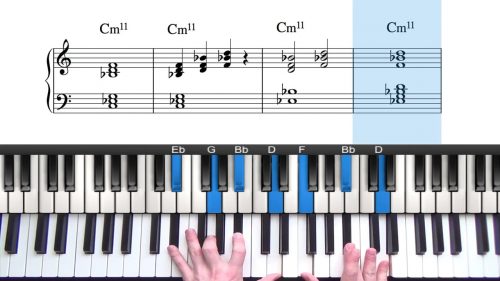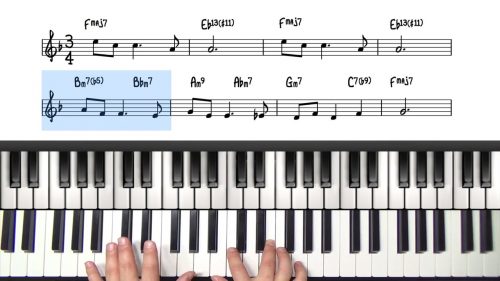Applying Upper Structures To Blue In Green
Blue in Green by Miles Davis contains a lot of upper extensions and alterations in the melody which makes it a perfect tune for applying upper structure triads.
We work through the whole form and apply upper structure triads to all of the dominant chords in the progression.
Before watching this lesson you should have watched the introduction lesson on upper structure triads so that you understand the construction and application on these voicings.
You may also find it helpful to watch the Part 1 of Blue in Green where we look at the basic harmony of the tune and touch upon upper structure application.
Lesson Downloads
-
“Blue in Green” Modal Scale Choices File Type: pdf
Practice Tips
I'd highly recommend that you print off the upper structure triad cheat sheet and stick this somewhere close to your piano/keyboard for easy reference.
When you come across a dominant chord on a lead sheet, identify the scale degree of the melody... is it an upper extension or alteration?
If so... chances are you can find a great sounding upper structure voicing.
It's through this process - of analysing the melody note and then finding a suitable voicings - that you will gain a deep understanding of upper structure triads and how to apply them to the tunes you are playing.








There is a vídeo for learning how to improvise this standard?
Hi Ivan,
Yes you can find that lesson here: pianogroove.com/jazz-piano-lessons/improvising-blue-in-green/
We talk about some general improvisation principles.
This cannot replace transcription. You must be transcribing your own lines and solos.
The best place to start is to listen and transcribe from your favourite recordings. In particular, transcribe lines over 251s, immediately transpose them around all 12 keys, and these ‘musical ideas’ will become the ‘words’ and ’sentences’ in your improvisations.
Enjoy!
Hayden
PianoGroove briefly
Hey Hayden,
At timestamp 10:16, where you use the 2nd inversion of the F# major triad, I’m a little bit confused on why that works. You mentioned the A mixolydian mode, and how we build the F# major triad from the 6 degree note of the A mixolydian mode. I have two questions:
1. Is the thought process: If the note is in the mode, you can build off from that note?
2. How do you determine the mode?
Thanks for your help, it’s always appreciated!
Sean
Hi Sean,
Good question!
The F# major triad works because of the melody note – Bb – which is the b9 of A7.
I mention the mixolydian mode mainly as a side note.
My thought process is:
Firstly, what are the melody notes over A7 in that bar?
The first melody note is C which is the #9 of A7. Looking at the Upper Structure Cheat Sheet, I know that a major triad built of the #5th will give me an upper structure triad with the #9 in the melody. The #5 of A7 is F, and voilla an F major triad over A7 in our left hand creates an A7#5#9 chord with the #9 in the melody.
The next melody note is Bb.
Bb is the b9 of A7.
Again using the upper structure cheat sheet, I know that if I build a major triad off the 13th, I will get an upper structure voicing containing 13, b9. and 3.
I build a major triad off the 13th of A7 which is an F# major triad, but in root position, I have C# in the melody.
I use the second inversion to get the Bb on top of the triad, which is what we need to harmonise the melody of that bar.
Does that help?
Remember to print off the Upper Structure Triad Cheat Sheet and stick it close to your piano for easy reference.
The trick is to memorise those formulas and then you can apply to any dominant chord.
Cheers!
Hayden
Hi Hayden,
At time stamp 12:19/14.47 with the measure that has B flat major, you went up the connected eighth notes and made chords out of them. I couldn’t figure out what you did, but they sounded beautiful. Were those block chords? I want to learn how to do that.
Thank you,
Rachel
Hi Rachel,
Great question!
Yes, these are indeed block chord voicings.
We have a dedicated course on block chords and drop 2 voicings, here it is: pianogroove.com/jazz-piano-lessons/block-chords-drop-2-voicings/
Watch the first theory lesson in this course and then explore some of the jazz standard lessons where we apply these voicings in the context of tunes.
Fly Me To The Moon is a nice standard to work on block chords, you will find this in the jazz standard module of the above course.
If you have any further questions, don’t hesitate to get in touch.
Cheers,
Hayden
Thank you so much Hayden! I’m really enjoying your courses and lessons. Once I’m done with the Upper Structure Triads courses, I’ll be tackling the courses you just mentioned. This is great!
Rachel